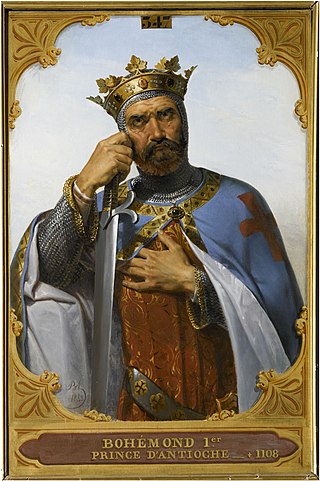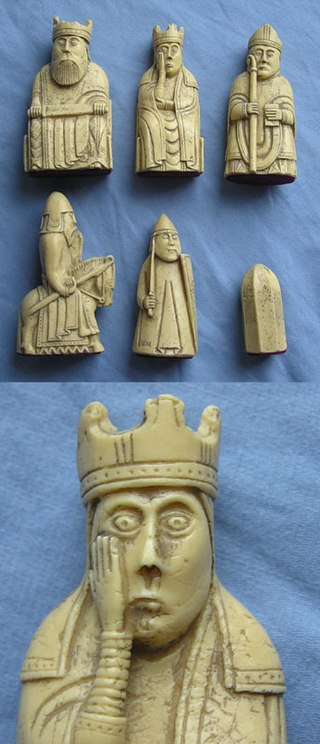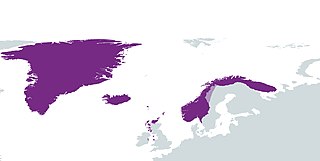Incumbents

- Monarchs – Eystein I Magnusson, Sigurd the Crusader (co-rulers)
| |||||
| Centuries: | |||||
|---|---|---|---|---|---|
| Decades: | |||||
| See also: | List of years in Norway | ||||
Events in the year 1123 in Norway.



Year 1123 (MCXXIII) was a common year starting on Monday of the Julian calendar.

Year 1103 (MCIII) was a common year starting on Thursday of the Julian calendar.
Eystein or Eysteinn is the name of:
Sigurd Magnusson, also known as Sigurd the Crusader, was King of Norway from 1103 to 1130. His rule, together with his half-brother Øystein, has been regarded by historians as a golden age for the medieval Kingdom of Norway. He is otherwise famous for leading the Norwegian Crusade (1107–1110), earning the eponym "the Crusader", and was the first European king to personally participate in a crusade.

Kungälv is a city and the seat of Kungälv Municipality in Västra Götaland County, Sweden. It had 22,768 inhabitants in 2010. In 2021, the main Kungälv - Ytterby - Kareby conurbation had a combined population approaching 30,000.
Magnus Erlingsson was a king of Norway during the civil war era in Norway. He was the first known Scandinavian monarch to be crowned in Scandinavia. He helped to establish primogeniture in royal succession in Norway. King Magnus was killed in the Battle of Fimreite in 1184 against the forces of Sverre Sigurdsson who became King of Norway.
Eystein II ; c.1125 – 21 August 1157) was king of Norway from 1142 to 1157. He ruled as co-ruler with his brothers, Inge Haraldsson and Sigurd Munn. He was killed in the power-struggle against his brother, Inge, in an early stage of the civil war era in Norway.
Sigurd Haraldsson, also called Sigurd Munn, was king of Norway from 1136 to 1155. He was son of Harald Gille, king of Norway and his mistress Thora Guttormsdotter. He served as co-ruler with his half-brothers, Inge Haraldsson and Eystein Haraldsson. His epithet Munn means "the Mouth" in Old Norse. He was killed in the power-struggle against his brother, Inge, in an early stage of the civil war era in Norway.

Eystein Magnusson was King of Norway from 1103 to 1123 together with his brothers Sigurd the Crusader and Olaf Magnusson, although since Olaf died before adulthood, only Eystein and Sigurd were effective rulers of the country.

Olav Magnusson was king of Norway in 1103–1115. He was the son of King Magnus Barefoot and Sigrid, daughter of Saxe of Vik.

The Fairhair dynasty was a family of kings founded by Harald I of Norway which united and ruled Norway with few interruptions from the latter half of the 9th century. In the traditional view, this lasted until 1387, however, many modern scholars view this rule as lasting only three generations, ending with Harald Greycloak in the late 10th century. The moniker "Fairhair dynasty" is a retrospective construction: in their lifetime what little traces there are refer to them consistently as "Ynglings".

Harald Maddadsson was Earl of Orkney and Mormaer of Caithness from 1139 until 1206. He was the son of Matad, Mormaer of Atholl, and Margaret, daughter of Earl Haakon Paulsson of Orkney. Of mixed Norse and Gaelic blood, and a descendant of Scots kings, he was a significant figure in northern Scotland, and played a prominent part in Scottish politics of the twelfth century. The Orkneyinga Saga names him one of the three most powerful Earls of Orkney along with Sigurd Eysteinsson and Thorfinn Sigurdsson.
Magnusson, or Magnússon, is a surname of Scandinavian origin, meaning son of Magnus. It may refer to:

The siege of Sidon was an event in the aftermath of the First Crusade. The coastal city of Sidon was captured by the forces of Baldwin I of Jerusalem and Sigurd I of Norway, with assistance from the Ordelafo Faliero, Doge of Venice.

The Norwegian Crusade, led by Norwegian King Sigurd I, was a crusade or a pilgrimage that lasted from 1107 to 1111, in the aftermath of the First Crusade. The Norwegian Crusade marks the first time a European king personally went to the Holy Land.
The Hardrada dynasty was a powerful royal dynasty which ruled, at various times in history, the Kingdom of Norway, the Kingdom of Mann and the Isles, and the Earldom of Orkney.
Events in the year 1115 in Norway.
Øystein is a Norwegian given name of Old Norse origins. One of its variants is Östen which is mostly used in Sweden. Notable people with the name include:

The term Norwegian Realm and Old Kingdom of Norway refer to the Kingdom of Norway's peak of power at the 13th century after a long period of civil war before 1240. The kingdom was a loosely unified nation including the territory of modern-day Norway, modern-day Swedish territory of Jämtland, Herjedalen, Ranrike (Bohuslän) and Idre and Särna, as well as Norway's overseas possessions which had been settled by Norwegian seafarers for centuries before being annexed or incorporated into the kingdom as 'tax territories'. To the North, Norway also bordered extensive tax territories on the mainland. Norway, whose expansionism starts from the very foundation of the Kingdom in 872, reached the peak of its power in the years between 1240 and 1319.
The Kalmare ledung was a crusade led by the Norwegian king Sigurd the Crusader performed in 1123 to Christianize the region of Småland. The crusade can be dated relatively accurately with information from Snorri Sturluson stating that the crusade must have taken place in the summer before the "great darkness". On 11 August 1124, a solar eclipse occurred, which means that the crusade most likely took place during the period June–August 1123.